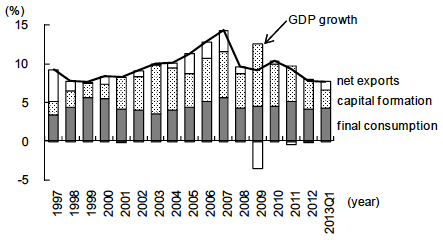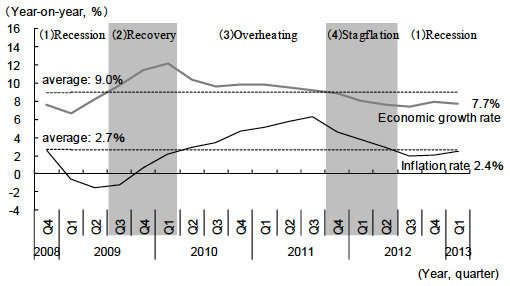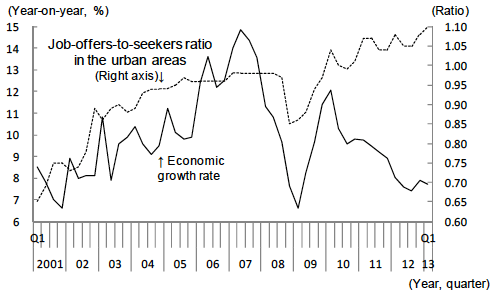The Chinese economy has continued to recover, but, hindered by the drop in the potential growth rate associated with the shortage of labor, the pace has been moderate.
The economic growth rate in terms of the real gross domestic product (GDP) in the first quarter of 2013 was 7.7% year-on-year, falling from 7.9% in the fourth quarter of 2012, according to the National Bureau of Statistics of China (NBSC). However, given that there were 91 days in the first quarter of 2012 due to the leap year and only 90 days in the first quarter of 2013, the GDP growth indicated by the NBSC is likely to underestimate the actual growth rate to some degree (Note 1). In fact, the Purchasing Managers' Index (PMI) in the manufacturing sector, which is less susceptible to the leap year factor, has recovered from its bottom of 49.2% in August 2012. It has remained consistently above the 50% line that separates expansion and contraction since October 2012, reaching 50.9% in March 2013, its highest level since April 2012.
By demand component, of the GDP growth in the first quarter of 2013, final consumption contributed 4.3%, capital formation (investment) contributed 2.3%, and net exports contributed 1.1%. As these figures suggest, the growth engine has been shifting from investment to consumption, and net exports are also on the way to recovery (Figure 1).

First, although the consumption of high-ticket items by the Communist Party cadres and government officials has been weak, reflecting efforts by the new leadership to promote discipline and thrift, consumption growth and income growth in rural areas have been exceeding those in urban areas, supporting overall consumption.
Meanwhile, regarding external demand, exports increased 18.4% year-on-year in the first quarter of 2013, showing strong growth against the backdrop of a recovery in the global economy. By region, although exports to Japan were stagnant, reflecting the lackluster relations between Japan and China, exports to emerging countries continued to be brisk, and those to the United States and the European Union (EU) also picked up (Note 2).
The economic recovery was triggered by the government's changing of its stance of macroeconomic policy from tightening to easing in the middle of last year, following a moderation of inflation. Although the inflation rate in terms of the consumer price index (CPI) (year-on-year growth) was only 2.4% in the first quarter of 2013, concerns were brewing that the inflation rate might start rising again in tandem with the economic recovery. However, this seems unlikely given that inflation, which is generally a lagging indicator of business conditions, tends to lag behind economic growth by about three quarters in the case of China.
As the inflation rate is a lagging indicator rather than a coincident indicator of the economic growth rate, depending on whether these two rates are higher or lower than their respective benchmarks, the business cycle can be divided into the four stages of 1) low growth and low inflation, 2) high growth and low inflation, 3) high growth and high inflation, and 4) low growth and high inflation, which respectively correspond to the recession, recovery, overheating, and stagflation stages of the business cycle. The average economic growth rate after the collapse of Lehman Brothers (from the fourth quarter of 2008 to the first quarter of 2013) was 9.0%, and the average inflation rate was 2.7%. Using these figures as benchmarks, in the first quarter of 2013, the Chinese economy was in a recession stage with low growth and low inflation (Figure 2). Although both the economic growth rate and inflation are expected to rise moderately in the second half of 2013, they are unlikely to surpass their respective benchmarks, and the Chinese economy should remain in the recession stage (Note 3).

The fact that China's economic growth rate remains low compared with the past not only reflects the short-term factor of the business cycle, but also the long-term factor of the falling potential growth rate due to changes in the labor market. More specifically, the working-age population (aged 15-59) in China fell in 2012 for the first time, as the result of the one-child policy that was introduced in 1980. In addition, surplus labor, which existed in large numbers in rural areas in the past, has almost been exhausted, and the Lewisian turning point, which signifies the achievement of full employment in the process of development, has already arrived. Against the backdrop of these developments, the job offers-to-seekers ratio in urban areas has kept rising, reaching an all-time high of 1.10 in the first quarter of 2013, despite the fact that the economic growth rate has fallen significantly (Figure 3).

Thus constrained by the supply of labor, the Chinese economy has been moving from a high-growth stage to a medium-growth stage. In keeping with this, the government has started to be less worried about the fall in employment that may result from a lower economic growth rate, but at the same time, even if the economy fully recovers, the economic growth rate is unlikely to return to its high level recorded in the past.


